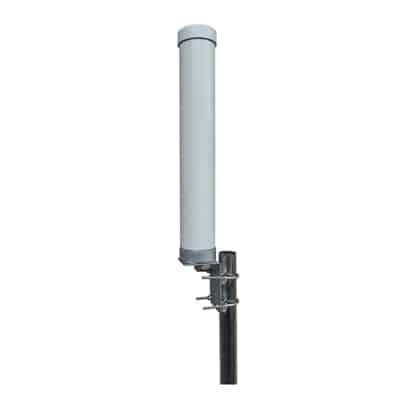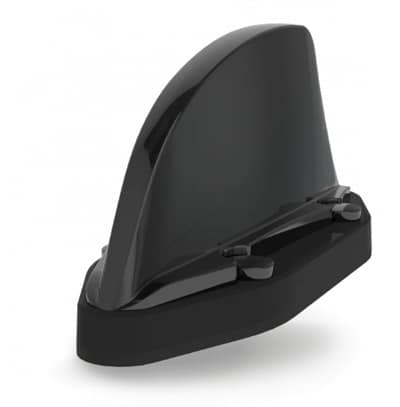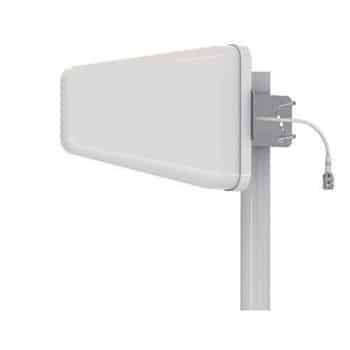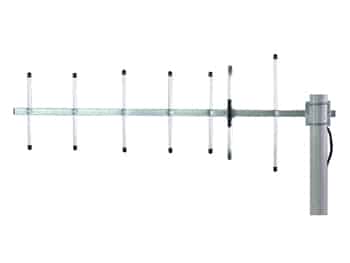
Recognizable in their slender rod/ wire design the whip antennas get their distinctive name due to the flexible whip-like motion they exhibit when struck. Even though simple in appearance, these antennas are used across a wide range of applications from portable radios to advanced communication systems. Its roots extending as far as the early days of radio communication, the whip antennas have since played an important role in the field of wireless communications.
This article wishes to explore the unique characteristics, types, use cases, and the technological aspects of whip antennas which set it apart as an indispensable role in the wireless communication landscape. Furthermore it aims to provide key pointers to consider when selecting and installing a whip antenna to ensure its optimum performance.
Table of Contents
ToggleIntroduction to Whip Antennas
The whip antenna was introduced in the development process for a portable radio communication system during World War II. The need for a reliable and compact communication device significantly contributed in materializing the current whip antenna design. These improvements thereafter led to the widespread adoption of whip antennas in portable radio frequency (RF) systems in civilian applications post-war, revolutionizing personal and commercial communication.
Being a fundamental element in RF communication systems the whip antenna typically features a thin flexible rod/wire with its bottom end connected to a transmitter or a receiver. As the antenna is mounted vertically it acts as signals radiating in every direction on a horizontal plane except for its conical blind spot.
Primarily used in high-frequency (HF), very high-frequency (VHF), and ultra-high-frequency (UHF) applications, whip antennas come in various lengths, with shorter ones paired up with handheld radios and walkie-talkies, while longer versions are mounted on roofs and radio masts, serving as base station antennas.
Design and Structure of Whip Antenna
The basic structure of a whip antenna consists of a straight, flexible wire or rod, typically made of a conductive material such as steel or aluminum. However for operations like portable radios, it can also be implemented as a series of interlocking metal tubes that can be retracted when not in use.
The elements of a typical whip antenna include,
1. Conductive Core:
A solid / stranded wire made out of stainless steel, copper-clad steel, or aluminum like materials.
2. Protective Sheath
The flexible rubber or plastic sheath covering, in addition to acting as a protective surface offers:
- Insulation, preventing accidental contact with the conductive element.
- In some cases, it adds to the antenna’s flexibility.
However this feature is mostly found in whip antennas functioning in adverse conditions.
3. Base Connector:
This attaches the whip antenna to the radio or mounting hardware. Threaded studs, BNC connectors, or SMA connectors are typically used based on the application.
4. Loading Coil:
Whip antennas designed for compact applications; incorporate a loading coil near to its base. This coil increases the effective electrical length of the antenna without increasing its physical size.
Antenna length is another important constraint in whip antenna design. The length of the antenna corresponds to the wavelength of its operational frequency range. With longer antennas used for lower frequencies (such as HF and VHF) and shorter ones for higher frequencies the length ranges from 1/10 wavelength long to 5/8 wavelength long with the most popular one being 1/4 wavelength.
However some short length whip antennas use techniques such as loading coils or capacitive hats to increase their electrical length without adding to their physical length due to practical considerations.
The material type used in a whip antenna affects the antenna’s conductivity, weight, and corrosion resistance ultimately contributing to its performance and durability. Some commonly used material types include,
- Steel:
Steel offers an excellent combination of strength and durability, making it a resilient choice.
- Aluminum:
The combination of good conductivity and lightweight makes it a popular choice for portable devices.
- Fiberglass:
As this offers a combination of strength, flexibility, and weather resistance this is more often used for longer whips, mounted on vehicles and structures.
Types of Whip Antenna
Monopole Whip Antenna
This is the most basic and widely used type of whip antenna. It consists of a single, straight conductor mounted perpendicular to a ground plane (the metal body of a vehicle or a counterpoise wire system which acts as the second half of the antenna system). Contributing to popularity is its:
- Simple, cost-effective design
- Typical length of one-quarter wavelength
- Omnidirectional radiation pattern in the horizontal plane
Monopole whip antennas are particularly effective for applications such as car radios, handheld transceivers, and base stations requiring a broad coverage area and where size is not a significant constraint.
Rubber Duck Antenna
This is a shortened and flexible version of the monopole whip antenna. Especially designed for portability and durability, its notable features include:
- Compact size, usually significantly shorter than a quarter-wavelength
- Encased in a rubber or plastic sheath for protection and flexibility
- A loading coil incorporated to compensate for the reduced length
While rubber duck antennas are excellent in portability and robustness, it comes at a tradeoff between their efficiency for their compact size. However, for many portable applications such as handheld devices like walkie-talkies, portable radios, and some Wi-Fi routers this trade-off is acceptable given the significant improvement in usability and durability.
Spring-Mounted Whip Antenna
Spring-mounted whip antennas are specially designed to operate in environments where there is risk of being subjected to physical stress or impacts. Its defining feature, the flexible spring base allows the antenna to bend and return to its original position making it suitable for maintaining consistent performance in challenging environments where a rigid antenna might fail or get frequently misaligned.
The spring mounted whip antenna is commonly used in vehicle-mounted applications, particularly for off-road vehicles and construction equipment where there is a need for considerable durability and resistance to damage from collisions or low-hanging obstacles.
Vehicle-Mounted Whip Antenna
This whip antenna type is specially designed according to the associated aerodynamics, wind and weather durability and easy assembly with automobiles, trucks, and other vehicles. Their unique features include:
- A variety of mounting options such as magnetic mounts, through-hole mounts, and clip-on mounts
- Tilt or fold-down mechanisms for clearance in low-height areas
Often longer than portable antennas, facilitating better performance at lower frequencies these antennas are mostly used for CB radios, amateur radio, and fleet communication systems.
Telescopic Whip Antenna
These antennas feature a series of interlocking tubes which enables it to adjust its length making it suitable for multi-band operations. Their notable features include:
- Ability to extend or retract to different lengths
- Compactness which makes them ideal for storage or transport
The adjustable nature of telescopic antennas enables users to manipulate their length for a range of frequencies, making them particularly useful in portable shortwave receivers, scanner radios, and TV antennas that operate across a wide frequency range.
Stubby Whip Antenna
Stubby whip antennas are the ultra-compact versions of whip antennas making it an ideal candidate for size critical applications. It is characterized by its:
- Extremely short length
- Heavily loaded inductance which compensates for its short length
Primarily used for UHF and higher frequency applications these whip antennas are most commonly used in modern smart phones, Bluetooth devices, and some tactical radio equipment.
While stubby antennas offer unparalleled compactness, they have the lowest efficiency among the whip antenna types. However, this trade off is outweighed by the significant size reduction it provides in many high-frequency consumer electronics applications.
Frequency Range and Applications
CB Radios (26.965 – 27.405 MHz)
Citizens Band (CB) radio is one of the most well-known applications of whip antennas. Operating in the HF/VHF crossover range, CB radios are widely used in:
- Trucking industry for communication between drivers
- Off-road enthusiasts for coordinating activities
- Emergency communication during natural disasters
- Local business operations for short-range team coordination
CB whip antennas are typically longer due to the lower frequency range, often around 102 inches (2.6 meters) for full-quarter wave antennas. However, shorter, loaded antennas are also common for more practical vehicle mounting.
VHF Band (30 – 300 MHz)
The whip antennas have a wide range of applications which falls under the Very High Frequency (VHF) band. Some of them include
- Marine VHF (156 – 174 MHz): Used for ship-to-ship and ship-to-shore communication
- FM Broadcasting (88 – 108 MHz): Even though not used in transmission, many portable FM radios use whip antennas for reception
- Emergency Services: Police, fire, and ambulance services often use VHF bands with vehicle-mounted whip antennas
While whip antennas operating in VHF range are generally shorter than CB antennas they are still long enough to be visible on vehicles or handheld devices.
UHF Band (300 MHz – 3 GHz)
Whip Antennas are also implemented in the Ultra High Frequency (UHF) band where many modern wireless technologies operate. Some of its use cases include:
- Cellular Networks (700 MHz – 2.6 GHz): Mobile phones often use internal whip-style antennas
- Wi-Fi (2.4 GHz and 5 GHz): Small whip antennas are used in many routers and Wi-Fi enabled devices.
- GPS (1.57542 GHz): For GPS receivers in vehicles or outdoor equipment.
- UHF TV Broadcasting (470 – 890 MHz): Even though not used in transmission, many portable TV sets use telescopic whip antennas for reception.
UHF whip antennas are typically much shorter than VHF whip antennas, often just a few inches long, which make them ideal in making compact devices.
IoT and Wireless Sensor Networks
Internet of Things (IoT) and wireless sensor networks rely on efficient, compact antennas to enable seamless connectivity. Operating mainly in the UHF and HF bands, these technologies often use whip antennas due to the efficiency, size, and cost-effectiveness they provide. Some common use cases include:
- LoRaWAN: Operating at frequencies such as 433 MHz, 868 MHz, and 915 MHz (region-dependent), LoRaWAN makes use of small whip antennas to ensure long-range, low-power communication.
- Zigbee and Bluetooth: Typically operating in the 2.4 GHz ISM band, these protocols benefit from whip antennas in using them in compact robust devices for short-range communication.
- NB-IoT and LTE-M: Cellular-based IoT solutions, operating in licensed cellular bands, often employ whip antennas to maintain reliable connections with a minimum amount of power consumption.
Specialized Applications
Whip antennas are also used in highly specialized fields, some of their specialized use cases include:
- Military Communications: Tactical radios employ robust whip antennas designed to operate across a range of frequency bands, ensuring reliable and robust communication.
- Aerospace: Aircraft communication systems utilize whip antennas for their aerodynamic design, to ensure efficient data transmission amidst air and wind disturbances.
- Weather Stations: Remote weather monitoring systems often depend on whip antennas for transmitting environmental data over long distances.
Advantages of Whip Antennas
Whip antennas offer several advantages that make them popular across a wide range of applications.
Simplicity and Cost-Effectiveness:
- Their straightforward design makes them easy to manufacture.
- Relatively inexpensive compared to other antenna types.
Omnidirectional Radiation Pattern:
- Ideal for mobile applications where there is frequent change in orientation.
- Effective for broadcasting and receiving from multiple directions.
Durability and Weather Resistance:
- Simple structure makes them resistant to environmental factors.
- Can be easily weatherproofed with protective coatings or sheaths.
- Spring-mounted versions offer excellent resistance to physical stress.
Low Visual Impact:
- The slender profile makes them less noticeable than many other antenna types.
- Can be easily concealed or integrated into existing structures.
Portability:
- Lightweight and easy to transport, especially their telescopic versions.
- Ideal for field operations and mobile communication systems.
Disadvantages of Whip Antennas
Even though whip antennas provide a considerable amount of advantages, they also have certain limitations such as:
Limited Gain: The omnidirectional radiation pattern of whip antenna results in a reduced gain compared to directional antennas which make it less suitable for long-range, point-to-point communications.
Susceptibility to Noise: As the antenna can pick up interference from all directions it will require additional filtering for noisy RF environments.
Length Constraints: The low frequency applications require longer whip antennas, which may not be practical. Also shortened whip antenna designs compromises efficiency for size.
Ground Plane Dependency: The antenna performance heavily on an adequate ground plane hence improper grounding can lead to inefficient and inadequate operation.
Limited Power Handling: Its thin profile can limit power handling capacity which makes it unsuitable for high-power transmitting applications
Whip Antenna vs. Dipole Antenna
Whip and dipole antennas are some of the widely used antenna types. Their differences in structure, size and operational functionalities makes them applicable for different use cases. The following is a comparison of key features highlighting their distinctions.
| Characteristic | Whip Antenna | Dipole Antenna |
| Structure | Single element with a ground plane | Two symmetrical elements |
| Size | Typically quarter-wavelength long | Usually half-wavelength long |
| Ground Plane | Requires a ground plane | Does not require a ground plane |
| Radiation Pattern | Omnidirectional in azimuth (horizontal plane) | Figure-eight pattern in azimuth |
| Impedance | Typically 30-50 ohms (with ground plane) | Close to 70 ohms |
| Applications | Mobile communications, portable devices | Fixed installations, broadband applications |
| Ease of Installation | Generally easier to install, especially in mobile applications | Requires more space and often support structures |
Whip Antenna vs. Stubby Antenna
Stubby antennas being a compact alternative to conventional whip antennas, offer unique advantages where size and durability are a priority. Therefore, even though there are similarities between the two types, there exist variations due to their design differences. Given below is a comparison between whip and stubby antennas outlining their uniqueness.
| Characteristic | Whip Antenna | Stubby Antenna |
| Size | Ranges from a few inches to several feet | Typically just a few inches long |
| Frequency Range: | Can be designed for a wide range of frequencies | Generally used for higher frequencies (UHF and above) |
| Efficiency | Generally more efficient, especially at lower frequencies | Less efficient due to its electrically short length |
| Bandwidth: | Often has wider bandwidth | Typically narrower bandwidth |
| Applications: | Versatile, used in various applications | Primarily used where compactness is crucial (e.g., handheld devices) |
| Durability: | Can be more susceptible to physical damage due to length | Generally more robust due to compact size |
| Aesthetics: | More visible and may affect device aesthetics | Less obtrusive, better for sleek device designs |
Does a Whip Antenna Need a Ground Plane?
A whip antenna needs a ground plane for it to operate in its full capacity. The key requirements that call for a ground plane are as follows:
- Electrical Balance:
As a whip antenna is more or less half of a dipole antenna, the ground plane acts as its “missing half”. This creates an effective mirror image of the antenna maintaining electrical balance and efficient operation.
- Radiation Pattern:
A proper ground plane ensures an omnidirectional radiation pattern in the horizontal plane without distortion which can result in uneven signal strength and reduced coverage.
- Impedance Matching:
The ground plane helps the whip antenna achieve the correct input impedance, ensuring efficient power transfer which otherwise may lead to signal loss and reduced antenna performance.
The types of ground planes associated with whip antennas can be classified as natural and artificial ground planes.
Natural ground planes include vehicle bodies, metal rooftops, or sometimes the Earth itself when used as a reflective surface.
Artificial ground planes are primarily radial wires, metal discs, or other conductive surfaces which creates an effective ground plane in fixed installations.
In the absence of a conventional ground plane the following alternatives can be used as an effective ground plane,
- Counterpoise Wires:
Radial wires arranged around the antenna base, providing a functional ground plane substitute.
- Loading Coils:
The inductance coils electrically lengthen the antenna, offering compensation for the lack of a ground plane however this results in a slight reduction in antenna performance.
- No-Ground-Plane (NGP) Antennas:
These are specially designed antennas that minimize dependence on the ground plane.
A well established ground plane ensures the optimum performance of the whip antenna. Therefore understanding its importance and available alternatives is essential in ensuring reliable and efficient communication across various applications.
Installation and Mounting
A properly installed whip antenna ensures it operates in its optimum condition for an extended period of time. The following includes several considerations to be made when installing and mounting a whip antenna.
1. Location
- A site with minimal physical obstructions allows better signal propagation.
- It is also to be noted the placing the antenna near other antennas, power lines, or large metallic objects may cause it RF disturbances.
2. Mounting Methods
- Magnetic Mounts: These are quick and portable mount types, which make them suitable for temporary setups but are less reliable in high-speed or harsh conditions.
- Permanent Mounts: These mounts require drilling into the mounting surface, which make them a stable option for long-term use.
- Clip-On Mounts: Particularly useful as temporary setups, these mounts can be easily attached without any modifications to the mounting surface.
3. Ground Plane Considerations
- Ensure excellent electrical contact between the antenna and the ground plane.
- For installations on non-metallic surfaces artificial ground planes like metal sheets or radial wires are to be used to mimic the grounding effect.
4. Cable Routing
- Use high-quality, low-loss coaxial cable to minimize signal loss.
- Make sure that the cable runs are as short as possible and avoid sharp bends that could degrade the signal.
6. Safety Considerations
- Avoid installation near overhead power lines or low-hanging obstacles, especially for tall antennas.
- Ensure the antenna is securely fastened to prevent detachment during movement or adverse weather conditions.
7. Tuning and Testing
- After installation, use an SWR (Standing Wave Ratio) meter to measure antenna performance and accordingly fine-tune the antenna length or position as necessary to achieve optimal SWR values and efficient operation.
Conclusion
In the dynamic landscape of wireless communications, whip antennas play an important role, offering versatile solutions for a wide range of applications. Despite their slender and simple design, these antennas stand out as indispensable components, thanks to their adaptability, cost-effectiveness, and ease of maintenance, making them integral in modern communication systems. Their ability to function across diverse environments and frequency ranges further highlights their practical significance.
While certain limitations exist, such as their reliance on a ground plane and constraints in gain, whip antennas continue to prove their relevance. Their unmatched reliability, simplicity, and flexibility guarantees seamless device connectivity and support innovation across countless applications, from traditional radio systems to emerging IoT technologies, solidifying their place in the evolving world of wireless technology.







